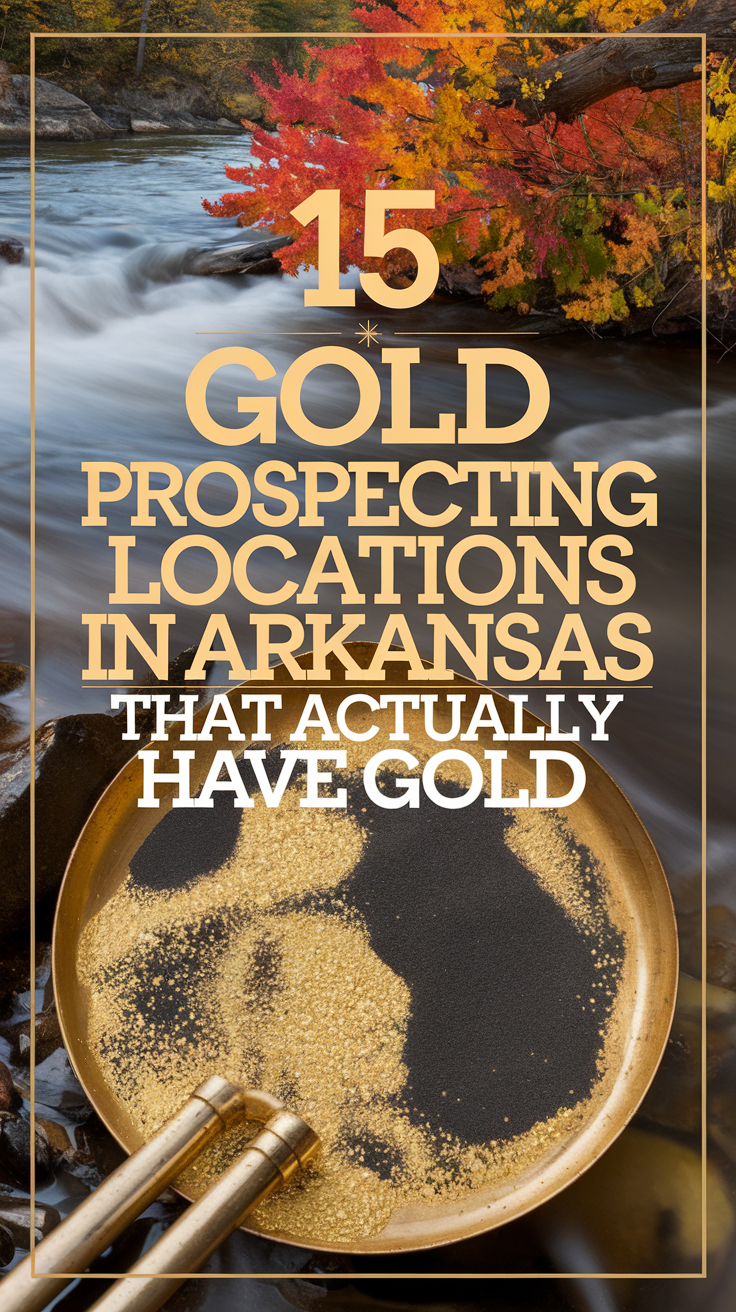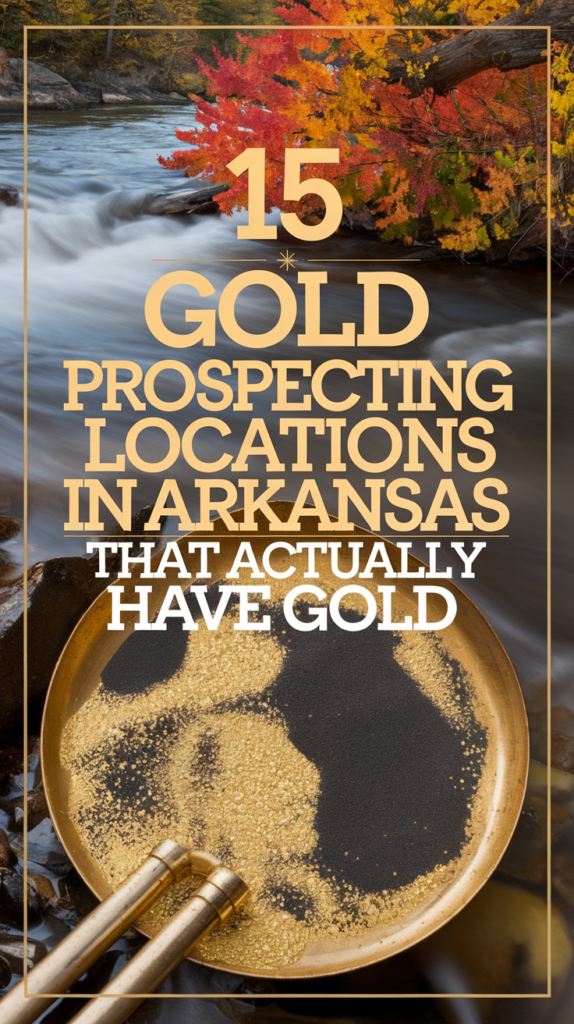
Arkansas might not be the first state that comes to mind when you think of gold prospecting, but the Natural State holds secrets that many prospectors overlook. While it may not rival California or Alaska in terms of gold production, Arkansas offers numerous locations where dedicated prospectors can still find gold today. From the Ouachita Mountains to the streams of the Arkansas River Valley, there are plenty of opportunities for both novice and experienced gold seekers. In this comprehensive guide, we’ll explore 15 proven locations where you can try your luck at finding Arkansas gold, complete with insider tips and essential information for a successful prospecting adventure.
Historical Context: Gold in Arkansas
Unlike many western states, Arkansas never experienced a major gold rush. However, gold has been discovered in various locations since the early 1800s, primarily in streams and rivers carrying placer deposits from the Ouachita Mountains. Most of the gold found in Arkansas is fine flour gold or small flakes, making it perfect for recreational prospecting but challenging for commercial mining operations.
The presence of gold in Arkansas is closely tied to the state’s geological history. During ancient mountain-building events, gold-bearing quartz veins formed within the Ouachita Mountains. Over millions of years, erosion broke down these deposits, distributing gold throughout the region’s waterways. While commercial mining never took off, the state’s geology continues to provide opportunities for modern-day prospectors.
Classic River Gold Locations (Locations 1-4)
1. Ouachita River
The Ouachita River stands as one of Arkansas’s premier gold prospecting locations. The best spots are found between Mount Ida and Hot Springs, where numerous small tributaries contribute to gold deposits. Look for:
– Deep bends in the river
– Areas below rapids
– Gravel bars during low water
– Natural sluices formed by rock formations
2. Little Missouri River
Located in Pike County, this river has produced consistent gold findings over the years. The most productive areas include:
– The stretch near Murfreesboro
– Confluence points with smaller streams
– Areas downstream from old mining operations
– Gravel bars with black sand deposits
3. Saline River
The Saline River offers excellent prospects, particularly in these areas:
- Sections near Benton
- Areas where the river cuts through ancient rock formations
- Downstream from the confluence with tributary creeks
- Locations with exposed bedrock
4. Caddo River
This location is particularly promising during spring and fall. Key prospecting areas include:
| Location Feature | Best Prospecting Method |
|---|---|
| Rocky outcrops | Sluicing |
| Gravel bars | Panning |
| River bends | Dredging (where permitted) |
| Tributary mouths | Crevicing |
Mountain Region Gold Spots (Locations 5-8)
5. Mount Ida Area
Known as the Quartz Crystal Capital of the World, Mount Ida also offers gold prospecting opportunities:
– Crystal Creek drainage areas
– Old mining claim sites
– Weathered quartz outcrops
– Stream beds below crystal deposits
6. Blakely Mountain
The streams around Blakely Mountain contain placer deposits worth investigating:
| Stream Section | Gold Type Usually Found |
|---|---|
| Upper reaches | Fine flour gold |
| Middle section | Small flakes |
| Lower areas | Larger flakes |
| Confluence points | Mixed deposits |
7. Hot Springs Creek Area
- Multiple access points near the national park
- Historical gold findings documented
- Rich in black sand deposits
- Best after heavy rains
8. Polk Creek Region
This area offers year-round prospecting opportunities with:
– Multiple public access points
– Known placer deposits
– Historical mining activity
– Good water flow throughout the year
Public Land Prospecting Areas (Locations 9-12)
9. Ouachita National Forest
The forest contains numerous prospecting locations:
– Wolf Creek area
– Board Camp Creek
– Multiple unnamed tributaries
– Ancient stream beds
10. Lake Ouachita State Park
The park’s streams and shorelines offer prospecting opportunities:
– Beach areas during low water
– Creek inlets
– Storm wash-outs
– Ancient river channels
11. DeGray Lake Region
Look for gold in:
– Tributary streams
– Exposed gravel bars
– Old river channels
– Storm deposit areas
12. Lake Catherine Area
Promising locations include:
– Creek mouths
– Shoreline deposits
– Ancient stream beds
– Weather-exposed areas
Lesser-Known Gold Locations (Locations 13-15)
13. Albert Pike Recreation Area
This area offers multiple prospecting opportunities:
– Little Missouri River access
– Multiple creek confluences
– Historic mining areas
– Natural sluice formations
14. Dry Creek Region
Despite its name, this area produces gold:
– After heavy rains
– In ancient stream beds
– Where bedrock is exposed
– At confluence points
15. Crystal Mountains Area
Beyond crystal hunting, gold can be found in:
– Stream sediments
– Weathered outcrops
– Old mining tailings
– Seasonal waterways
Conclusion
While Arkansas may not be famous for gold mining, these 15 locations offer genuine opportunities for finding gold. Success requires patience, proper equipment, and knowledge of the area’s geology. Remember to always check local regulations, obtain necessary permits, and respect private property boundaries. Whether you’re a weekend prospector or a serious gold hunter, these locations provide a solid starting point for your Arkansas gold prospecting adventure.
Key Takeaways
- Most productive areas are in the Ouachita Mountain region
- Spring and fall are typically the best seasons for prospecting
- Fine flour gold is most common in Arkansas
- Always obtain necessary permits before prospecting
- Focus on areas with historical mining activity
Frequently Asked Questions
Do I need a permit to prospect for gold in Arkansas?
Yes, most locations require either a recreational prospecting permit or landowner permission. Always check with local authorities and obtain necessary permits before prospecting.
What’s the best time of year to prospect for gold in Arkansas?
Spring and fall are typically the best seasons, offering comfortable temperatures and moderate water levels. After heavy rains can be particularly productive.
What type of gold can I expect to find in Arkansas?
Most gold found in Arkansas is fine flour gold or small flakes. Nuggets are rare but not impossible to find.
What equipment do I need to start prospecting?
Basic equipment includes gold pans, sluice boxes, classifiers, and proper digging tools. More advanced prospectors might use metal detectors or dredges where permitted.
Are there any restricted areas where prospecting is prohibited?
Yes, prospecting is prohibited in state parks unless specifically permitted, and some federal lands have restrictions. Always verify access rights before prospecting.
Can I keep the gold I find?
Yes, recreational prospectors can keep their findings, but commercial mining requires special permits and licenses.
What’s the best method for prospecting in Arkansas streams?
Panning and sluicing are most effective for Arkansas’s fine gold. Focus on areas where water flow naturally concentrates heavy materials.
Is it possible to prospect year-round in Arkansas?
Yes, though some seasons are more comfortable and productive than others. Winter can be challenging due to cold water temperatures.
How can I identify promising locations for gold?
Look for areas with black sand, quartz outcrops, and natural concentration points like river bends and bedrock cracks.
What safety precautions should I take while prospecting?
Always prospect with a partner, watch for wildlife, carry first aid supplies, and be aware of weather conditions. Wear appropriate gear including water shoes with good grip.


